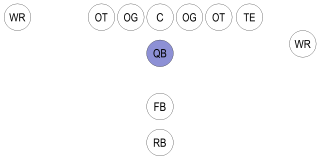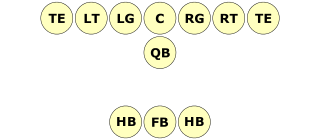
The quarterback, colloquially known as the "signal caller", is a position in gridiron football. Quarterbacks are members of the offensive team and line up directly behind the offensive line. In modern American football, the quarterback is usually considered the leader of the offensive team, and is often responsible for calling the play in the huddle. The quarterback also touches the ball on almost every offensive play, and is the offensive player that almost always throws forward passes. When the QB is tackled behind the line of scrimmage, it is called a sack.

A running back (RB) is a member of the offensive backfield in gridiron football. The primary roles of a running back are to receive handoffs from the quarterback to rush the ball, to line up as a receiver to catch the ball, and block. There are usually one or two running backs on the field for a given play, depending on the offensive formation. A running back may be a halfback, a wingback or a fullback. A running back will sometimes be called a "feature back" if he is the team's starting running back.

The tight end (TE) is a position in American football, arena football, and formerly Canadian football, on the offense. The tight end is often a hybrid position with the characteristics and roles of both an offensive lineman and a wide receiver. Like offensive linemen, they are usually lined up on the offensive line and are large enough to be effective blockers. On the other hand, unlike offensive linemen, they are eligible receivers adept enough to warrant a defense's attention when running pass patterns.

An option offense is a style of offense in American football that is predominantly based on a running play. However, instead of a specific play in mind, the offense has several "options" of how to proceed. Based on the defense, the quarterback may hand off to a fullback up the middle (dive), hold on to the ball and run himself to either side of the field (keep), or pitch the ball to a trailing running back (pitch). Option offenses have traditionally relied heavily upon running plays, though modern option offenses now incorporate some passing plays called the Run-Pass Option or RPOs. Because they are run-based, option offenses are very effective in managing the game clock, giving the opposing team less time to score and keeping the option team's defense from tiring. However, this also means that when the option team is losing near the end of the game, and needs to score quickly, it is at a disadvantage. These schemes rely on timing, deception, and split-second decision-making under pressure, which, in turn, require precise execution and discipline.

An end in American and Canadian football is a player who lines up at either end of the line of scrimmage, usually beside the tackles. Rules state that a legal offensive formation must always consist of seven players on the line of scrimmage and that the player on the end of the line constitutes an eligible receiver.

The wishbone formation, also known simply as the bone, is an offensive formation in American football. The style of attack to which it gives rise is known as the wishbone offense. Like the spread offense in the 2000s, the wishbone was considered to be the most productive and innovative offensive scheme in college football during the 1970s and 1980s.

In American football, a T formation is a formation used by the offensive team in which three running backs line up in a row about five yards behind the quarterback, forming the shape of a "T".

A halfback (HB) is an offensive position in American football, whose duties involve lining up in the backfield and carrying the ball on most rushing plays, i.e. a running back. When the principal ball carrier lines up deep in the backfield, and especially when that player is placed behind another player, as in the I formation, that player is instead referred to as a tailback.

The spread offense is an offensive scheme in gridiron football that typically places the quarterback in the shotgun formation, and "spreads" the defense horizontally using three-, four-, and even five-receiver sets. Used at every level of the game including professional, college, and high school programs across the US and Canada, spread offenses often employ a no-huddle approach. Some implementations of the spread also feature wide splits between the offensive linemen.
In American football, Air Coryell is the offensive scheme and philosophy developed by former San Diego Chargers coach Don Coryell. The offensive philosophy has been also called the "Coryell offense" or the "vertical offense".

In American football, the 3–3–5 defense is a defensive alignment consisting of three down linemen, three linebackers, and five defensive backs. The 3–3–5 defense can also be referred to as the 3-3 stack and the Spread Defense. It is one form of the nickel defense, a generic term for a formation with five defensive backs. Veteran college football defensive coordinator Joe Lee Dunn is widely credited with being the main innovator of the 3-3-5 scheme.

A pro-style offense in American football is any offensive scheme that resembles those predominantly used at the professional level of play in the National Football League (NFL), in contrast to those typically used at the collegiate or high school level. Pro-style offenses are fairly common at top-quality colleges but much less used at the high school level. The term should not be confused with a pro set, which is a specific formation that is used by some offenses at the professional level.
The A-11 offense is an offensive scheme that has been used in some levels of amateur American football. In this offense, a loophole in the rules governing kicking formations is used to disguise which offensive players would be eligible to receive a pass for any given play. It was designed by Kurt Bryan and Steve Humphries of Piedmont High School in California.
The following terms are used in American football, both conventional and indoor. Some of these terms are also in use in Canadian football; for a list of terms unique to that code, see Glossary of Canadian football.
Wildcat formation describes a formation for the offense in football in which the ball is snapped not to the quarterback but directly to a player of another position lined up at the quarterback position. The Wildcat features an unbalanced offensive line and looks to the defense like a sweep behind zone blocking. A player moves across the formation prior to the snap. However, once this player crosses the position of the running back who will receive the snap, the play develops unlike the sweep.

In American football, the 4–4 defense is a defensive alignment consisting of four down linemen and four linebackers.
In American football, a smashmouth offense is an offensive system that relies on a strong running game, where most of the plays run by the offense are handoffs to the fullback or tailback. It is a more traditional style of offense that often results in a higher time of possession by running the ball heavily. So-called "smash-mouth football" is often run out of the I-formation or wishbone formation, with tight ends and receivers used as blockers. Though the offense is run-oriented, pass opportunities can develop as defenses play close to the line. Play-action can be very effective for a run-oriented team.

A defensive tackle (DT) is a position in American football that will typically line up on the line of scrimmage, opposite one of the offensive guards, however he may also line up opposite one of the tackles. Defensive tackles are typically the largest and strongest of the defensive players. Depending on a team's individual defensive scheme, a defensive tackle may be called upon to fill several different roles. These roles may include merely holding the point of attack by refusing to be moved, or penetrating a certain gap between offensive linemen to break up a play in the opponent's backfield. If a defensive tackle reads a pass play, his primary responsibility is to pursue the quarterback, or simply knock the pass down at the line if it is within arm's reach. Other responsibilities of the defensive tackle may be to pursue the screen pass or drop into coverage in a zone blitz scheme. In a traditional 4–3 defense, there is no nose tackle. Instead there is a left and right defensive tackle. Some teams, especially in the National Football League (NFL), do have a nose tackle in this scheme, but most of them do not.
A play calling system in American football is the specific language and methods used to call offensive plays.












